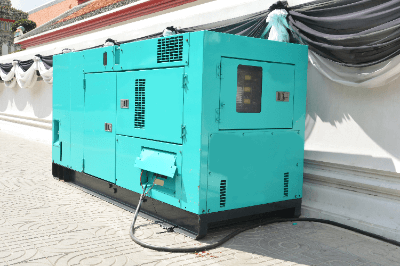What Is an Emergency Power Generator?

Emergency power generators are power generation devices installed for disaster prevention and security purposes in anticipation of sudden power outages due to disasters.
If the power supply stops, there is a risk of secondary disasters due to communication lines being interrupted in buildings, hospitals, and other facilities. The installation of emergency generators is essential to prepare for such a situation.
Emergency generators are mainly engine power generators and gas turbine power generators. It is vital to select the right one for the application and the building in which it will be used. Both are highly reliable and can be used as high-quality power supply units.
Uses of Emergency Power Generators
Emergency power generators are used in locations with a risk of secondary disasters in the event of a sudden power outage. Examples of use are listed below.
In some of the above cases, the installation of emergency power sources is required by law.
Principle of Emergency Power Generators
The power generation mechanism uses the principle of electromagnetic induction to generate electromotive force when a conductor crosses a magnetic field.
Since emergency generators must be able to be used reliably in an emergency, they are equipped with a system that detects power outages and quickly switches to the generated power source. They are also vibration-resistant so that they can operate even in an earthquake.
Types of Emergency Power Generators
Emergency generators are mainly engine generators and gas turbine generators.
Diesel generators use a diesel engine for motive power, and an alternator is directly connected to the diesel engine to generate electricity. It takes a short time to start and has a high thermal efficiency of about 35% to 40%. They are also highly reliable power generators in terms of their start-up.
Gas turbine generators are air-cooled for emergency use. Since no cooling water is required, there is no risk of turbine failure due to freezing or water cutoff. Another feature is that the installation area is smaller than for diesel engines.
Other Information on Emergency Power Generators
Emergency power generators must undergo three periodic inspections to ensure reliable operation in an emergency.
Periodic Inspection Based on the Electricity Business Act
This inspection performs a no-load operation (dry run) for about 5 minutes with the electrical system turned on.
Periodic Inspection Based on the Fire Service Act
A visual functional inspection is conducted every six months, and a no-load operation is done annually.
Load Test Operation in Accordance With the Fire Service Act
This test must be conducted once a year. Emergency power generators are connected to a load test device and operated continuously for 30 minutes with a load of 30% or more. During the load test operation, we confirm that there are no abnormalities, such as abnormal vibration or heat generation, in the emergency power generator and that the operation is normal. In addition, it also serves to burn off the carbon generated during the no-load operation.
As mentioned above, the load test operation requires the connection of the load test equipment to the emergency power generator. However, this may be difficult depending on the location of the emergency power generator. However, the Fire Service Law was revised in 2019, and gas turbine emergency power generators are no longer required to perform load test operations. Even for equipment requiring a load test, the inspection is now considered equivalent to a load test by conducting the prescribed internal observations if it is challenging to conduct a load test.
Emergency power generators vary widely in price, depending on the generation method and capacity. For a small unit for home use, a 45,000mAh/3.7V/167Wh/rated 150W solar-charged and lithium-ion battery storage type generator can be purchased for 10,000 yen or less.
On the other hand, emergency power generators used in stores and server rooms are gas turbine-powered and cost several million yen or more. Many engine emergency power generators are also available for large facilities, and like gas turbine generators, they are priced in the millions of yen to several million yen range.